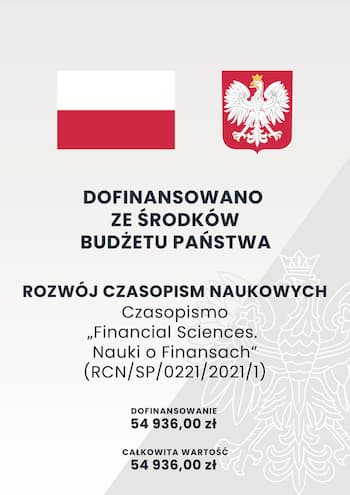Issues
Click a year to expand it.
40 Points
on Ministry of Education and Science journal evaluation list of 2024

Search results for query: Kaczmarzyk
Sort by: Relevance Author: Ascending Descending Year: Ascending Descending
- Should We Assume the Discount Rate to Be One of the Risk Factors
Author: Jan Kaczmarzyk
See Issue Contents: fins.2023.2
Abstract:Financial models implemented in corporate finance mostly rely on the discounted cash flow valuation approach. The basic concepts behind various forms of a discounted cash flow valuation are the present value of an asset and the net present value of an asset. Both concepts use a discount rate as a required rate of return for investors or broadly investors and lenders together depending on a particular analytical situation and the type of free cash flow stream. The Monte Carlo simulation is the ultimate solution for considering nearly all possible scenarios in presumably any discounted cash flow valuation. The Author of this paper argues that a discount rate expresses an investor’s cur-rent requirement and should be respectively perceived as a parameter only. The consequences of qualifying a required rate of return (a discount rate) as a risk factor in a dis-counted cash flow valuation are depicted in the paper using a free cash flow financial model of an asset being a hypothetical publicly traded enterprise. The case study is a discounted cash flow valuation using the Monte Carlo simulation for risk analysis. The various sets of assumptions are considered to explain the consequences of qualifying a required rate of return in a discounted cash flow model as a risk factor. As has been in-dicated in the paper, the discount rate as an additional risk factor with an attributed probability distribution increases the volatility of a risk variable. The distribution of a risk variable becomes more flattened then. In previous studies, some Authors indicated that a discount rate could be considered a risk factor in the Monte Carlo simulation (Krysiak 2000, Damodaran 2018).
- Forecasting currency risk in an enterprise using the Monte Carlo simulation
Author: Jan Kaczmarczyk
See Issue Contents: fins.2018.4
Abstract:A non-financial enterprise with receivables or liabilities denominated in a foreign currency is exposed to currency risk. Wanting to calculate a financial reserve in order to secure its receivables or liabilities, an enterprise can introduce the concept of the value at risk. To determine value at risk, an enterprise has to know the probability distribution of the future value of the receivable or the liability for a specific moment in future. Using a geometric Brownian motion to reflect exchange rate changes is among the possible solutions. The aim of the paper is to indicate that using the Monte Carlo simulation for forecasting the currency risk of an enterprise is a clear, easy-to-implement and flexible in terms of the assumptions approach. The flexibility of the Monte Carlo approach relies on the possibility to take up the assumption that the currency position changes caused by currency fluctuations have an other than normal probability distribution






